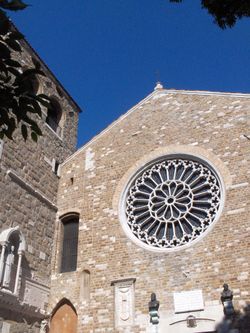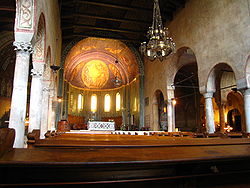
Trieste Cathedral
Encyclopedia


Justus of Trieste
Saint Justus of Trieste is a Roman Catholic saint.According to his passio , he was a citizen of Triest in Italy, known for his works and charities. When charges of being a Christian were brought against him by his fellow citizens, he was tried according to Roman law...
, is the cathedral
Cathedral
A cathedral is a Christian church that contains the seat of a bishop...
and main church of Trieste
Trieste
Trieste is a city and seaport in northeastern Italy. It is situated towards the end of a narrow strip of land lying between the Adriatic Sea and Italy's border with Slovenia, which lies almost immediately south and east of the city...
, in northern Italy
Italy
Italy , officially the Italian Republic languages]] under the European Charter for Regional or Minority Languages. In each of these, Italy's official name is as follows:;;;;;;;;), is a unitary parliamentary republic in South-Central Europe. To the north it borders France, Switzerland, Austria and...
. It is the seat of the Bishop of Trieste.
History
The first religious edifice on the site was built in the 6th century on some RomanAncient Rome
Ancient Rome was a thriving civilization that grew on the Italian Peninsula as early as the 8th century BC. Located along the Mediterranean Sea and centered on the city of Rome, it expanded to one of the largest empires in the ancient world....
propylaea, using part of the existing structure. Perhaps the entrance to a monument, this was commonly known as the Capitoline Temple, as a pyramidal altar
Altar
An altar is any structure upon which offerings such as sacrifices are made for religious purposes. Altars are usually found at shrines, and they can be located in temples, churches and other places of worship...
with the symbols of the Capitoline Triad
Capitoline Triad
In ancient Roman religion, the Capitoline Triad was a group of three supreme deities who were worshipped in an elaborate temple on Rome's Capitoline Hill, the Capitolium. Two distinct Capitoline Triads were worshipped at various times in Rome's history, both originating in ancient traditions...
(Jupiter
Jupiter (mythology)
In ancient Roman religion and myth, Jupiter or Jove is the king of the gods, and the god of the sky and thunder. He is the equivalent of Zeus in the Greek pantheon....
, Juno
Juno (mythology)
Juno is an ancient Roman goddess, the protector and special counselor of the state. She is a daughter of Saturn and sister of the chief god Jupiter and the mother of Mars and Vulcan. Juno also looked after the women of Rome. Her Greek equivalent is Hera...
and Minerva
Minerva
Minerva was the Roman goddess whom Romans from the 2nd century BC onwards equated with the Greek goddess Athena. She was the virgin goddess of poetry, medicine, wisdom, commerce, weaving, crafts, magic...
) had been found inside it.
Of the hall there remains part of the mosaic
Mosaic
Mosaic is the art of creating images with an assemblage of small pieces of colored glass, stone, or other materials. It may be a technique of decorative art, an aspect of interior decoration, or of cultural and spiritual significance as in a cathedral...
floor, integrated into the present-day floor, which contains markings of the outer walls of the early Christian
Christianity
Christianity is a monotheistic religion based on the life and teachings of Jesus as presented in canonical gospels and other New Testament writings...
building. Soon after it was opened for worship, the church was destroyed in the Lombard
Lombards
The Lombards , also referred to as Longobards, were a Germanic tribe of Scandinavian origin, who from 568 to 774 ruled a Kingdom in Italy...
invasion.
Between the 9th and 11th centuries, two basilica
Basilica
The Latin word basilica , was originally used to describe a Roman public building, usually located in the forum of a Roman town. Public basilicas began to appear in Hellenistic cities in the 2nd century BC.The term was also applied to buildings used for religious purposes...
s were erected on the ruins of the old church, the first dedicated to Our Lady of the Assumption
Assumption of Mary
According to the belief of Christians of the Roman Catholic Church, Eastern Orthodoxy, Oriental Orthodoxy, and parts of the Anglican Communion and Continuing Anglicanism, the Assumption of Mary was the bodily taking up of the Virgin Mary into Heaven at the end of her life...
and the second, the cathedral, to Saint Justus (San Giusto). The original design of the latter building was subsequently lengthened. In the 14th century the two basilicas were joined by means of the demolition of one nave
Nave
In Romanesque and Gothic Christian abbey, cathedral basilica and church architecture, the nave is the central approach to the high altar, the main body of the church. "Nave" was probably suggested by the keel shape of its vaulting...
of either basilica and the construction of a simple asymmetrical façade, dominated by a delicately worked Gothic
Gothic architecture
Gothic architecture is a style of architecture that flourished during the high and late medieval period. It evolved from Romanesque architecture and was succeeded by Renaissance architecture....
rose window
Rose window
A Rose window is often used as a generic term applied to a circular window, but is especially used for those found in churches of the Gothic architectural style and being divided into segments by stone mullions and tracery...
, as ornate as the new bell tower
Bell tower
A bell tower is a tower which contains one or more bells, or which is designed to hold bells, even if it has none. In the European tradition, such a tower most commonly serves as part of a church and contains church bells. When attached to a city hall or other civic building, especially in...
, using the Romanesque
Romanesque architecture
Romanesque architecture is an architectural style of Medieval Europe characterised by semi-circular arches. There is no consensus for the beginning date of the Romanesque architecture, with proposals ranging from the 6th to the 10th century. It developed in the 12th century into the Gothic style,...
debris stones found on the site and frieze
Frieze
thumb|267px|Frieze of the [[Tower of the Winds]], AthensIn architecture the frieze is the wide central section part of an entablature and may be plain in the Ionic or Doric order, or decorated with bas-reliefs. Even when neither columns nor pilasters are expressed, on an astylar wall it lies upon...
s of arms.
Carlist mausoleum
The Chapel of Saint Charles Borromeo serves as the burial chapel for the family of the CarlistCarlism
Carlism is a traditionalist and legitimist political movement in Spain seeking the establishment of a separate line of the Bourbon family on the Spanish throne. This line descended from Infante Carlos, Count of Molina , and was founded due to dispute over the succession laws and widespread...
claimants to the throne of Spain
Spain
Spain , officially the Kingdom of Spain languages]] under the European Charter for Regional or Minority Languages. In each of these, Spain's official name is as follows:;;;;;;), is a country and member state of the European Union located in southwestern Europe on the Iberian Peninsula...
. It contains the tombs of:
- Infante Carlos, Count of MolinaInfante Carlos, Count of MolinaThe Infante Carlos of Spain was the second surviving son of King Charles IV of Spain and of his wife, Maria Luisa of Parma. As Carlos V he was the first of the Carlist claimants to the throne of Spain...
(Carlos V) - Infanta Maria Francisca of Portugal, first wife of the Count of Molina
- Teresa, Princess of BeiraTeresa, Princess of BeiraInfanta Maria Teresa of Portugal was the firstborn child of John VI of Portugal and Charlotte of Spain, and heir to the throne of Portugal between 1793 and 1795, until her short-lived brother António Pio was born.Maria Teresa Francisca de Assis Antónia Carlota Joana Josefa Xavier de Paula Micaela...
, second wife of the Count of Molina - Infante Carlos, Count of MontemolinInfante Carlos, Count of MontemolinInfante Carlos, Conde de Montemolín was the Carlist claimant to the throne of Spain under the name Carlos VI after his father's abdication in 1845, when he took the title of Count of Montemolín.-Biography:...
(Carlos VI) - Princess Maria Carolina of Bourbon-Two SiciliesPrincess Maria Carolina of Bourbon-Two SiciliesPrincess Maria Carolina Ferdinanda of Bourbon-Two Sicilies was a princess of the House of Bourbon-Two Sicilies and an infanta of Spain through her marriage to Infante Carlos, Count of Montemolin, Carlist claimant to the throne of Spain under the name Carlos VI...
, wife of the Count of Montemolin - Juan, Count of MontizónJuan, Count of MontizónDon Juan Carlos María Isidro de Borbón, Count of Montizón was the Carlist claimant to the throne of Spain from 1860 to 1868, and the Legitimist claimant to the throne of France from 1883 to 1887.- Youth and marriage :...
(Juan III) - Infante Fernando of Spain, brother of the Count of Montemolin and the Count of Montizón
- Carlos, Duke of MadridCarlos, Duke of MadridInfante Carlos María de los Dolores Juan Isidro José Francisco Quirin Antonio Miguel Gabriel Rafael de Borbón y Austria-Este, Duke of Madrid was the senior member of the House of Bourbon from 1887 until his death...
(Carlos VII) - Archduke Karl Pius of Austria, Prince of TuscanyArchduke Karl Pius of Austria, Prince of TuscanyArchduke Karl Pius of Austria, Prince Royal of Hungary and Bohemia, Prince of Tuscany , called Carlos Pío de Habsburgo-Lorena y de Borbón in Spain, was a member of the Tuscan branch of the Imperial House of Habsburg and a Carlist claimant to the throne of Spain under the assumed name of "Carlos...
(Carlos VIII)
Works of art
Among the works of historical interest in the cathedral are the apsidalApse
In architecture, the apse is a semicircular recess covered with a hemispherical vault or semi-dome...
mosaics depicting Our Lady of the Assumption and Saint Just, laid by master craftsmen from Veneto
Veneto
Veneto is one of the 20 regions of Italy. Its population is about 5 million, ranking 5th in Italy.Veneto had been for more than a millennium an independent state, the Republic of Venice, until it was eventually annexed by Italy in 1866 after brief Austrian and French rule...
in the 12th-13th centuries. The small 14th-century church of San Giovanni (Saint John), the old baptistry) on the left and San Michele al Carnale on the right, by the entrance to the museum
Museum
A museum is an institution that cares for a collection of artifacts and other objects of scientific, artistic, cultural, or historical importance and makes them available for public viewing through exhibits that may be permanent or temporary. Most large museums are located in major cities...
, complete a fine medieval
Middle Ages
The Middle Ages is a periodization of European history from the 5th century to the 15th century. The Middle Ages follows the fall of the Western Roman Empire in 476 and precedes the Early Modern Era. It is the middle period of a three-period division of Western history: Classic, Medieval and Modern...
churchyard
Churchyard
A churchyard is a patch of land adjoining or surrounding a church which is usually owned by the relevant church or local parish itself. In the Scots language or Northern English language this can also be known as a kirkyard or kirkyaird....
.
In the square in front of the church is an altar commemorating the consecration and laying down of the arms of the 3rd Army, a column with a halberd and a monument to those who died in the First World War.
Archaeological excavations carried out here in the 1930s laid bare the remains of the Roman forum and civic building constructed on two colonnaded floors with two apses. Two lower-floor columns have been reconstructed.

